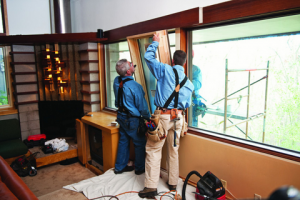Illinois’ Clean Energy Jobs Act taps power of energy efficiency
 By Christie Hicks and Andrew Barbeau
By Christie Hicks and Andrew Barbeau
This post is the fourth in our CEJA series.
The rollout of Illinois’ Clean Energy Jobs Act (CEJA) has focused attention on the bill’s four main pillars: a 100% renewable energy target by 2050, the decarbonization of the state’s power sector by 2030, the electrification of the transportation sector and a focus on equity and economic justice.
But there’s a hidden gem of an opportunity in the bill that is just as promising as solar panels and electric cars: energy efficiency.
Energy efficiency programs and technology are among the most cost-effective routes to lower climate emissions and energy bills. And just like solar, wind and other clean energy tools, it’s a job creator. CEJA recognizes and capitalizes on that potential.
First, CEJA will reverse a 2016 decision by then-Governor Bruce Rauner that exempted large commercial and industrial customers from utilities’ energy efficiency programs. That wrong-headed move meant that some of the state’s biggest customers — huge firms like ADM and Caterpillar — don’t have to pay into energy efficiency programs. And it also means that some customers, such as hospitals and some cities, cannot participate even though they might want to.
Illinois’ Clean Energy Jobs Act taps power of energy efficiency Share on XSecond, it provides for transparent utility investment planning that prioritizes new, efficiency-focused technologies where utilities would otherwise invest in traditional infrastructure. Rather than solely relying on new poles and wires, substations or pipelines, utilities would be required to consider whether efficiency and clean energy alternatives can meet the same needs – potentially at significant cost savings for customers.
One of the greatest opportunities for energy efficiency is in low-income home retrofits.
Sealing homes and replacing inefficient windows and appliances saves energy and money. Unfortunately, we have seen a high number of “walk aways” in recent years – energy efficiency installers will go to a low-income home to perform an upgrade, but will walk away because they detect health or safety violations, such as asbestos, a leaky roof or something else that they alone cannot solve and the homeowner can’t afford.
CEJA includes a new Health and Safety Fund that will supplement necessary safety improvements so low-income residential and non-profit buildings don’t miss out on important efficiency opportunities because of budget concerns. As a result, we can make a home or building safer, healthier and more efficient all at once – and not have to abandon projects.
The legislation also calls for more program bundling and closer coordination of energy efficiency, Illinois Solar For All and electrification incentives with low-income assistance programs such as Low Inclome Home Energy Assistance Program (LIHEAP), Percentage of Inclome Payment Plan Plus (PIPP) and utility hardship programs. This coordinated strategy will better serve the people who need help the most.
Energy efficiency should form the basis of any robust clean energy policy, and it will with CEJA. The cheapest, cleanest energy is the energy we don’t use. EDF urges Illinois legislators to make use of this abundant Illinois resource.










